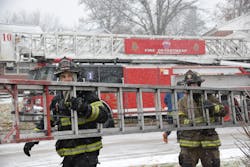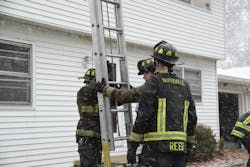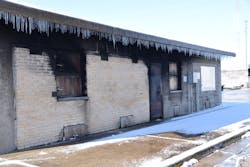Preparedness and Training for Cold-Weather Firefighting
As the months of winter creep up on us, subfreezing temperatures sweep their way across many parts of North America. Fire departments that operate in these frigid parts of the continent face many special challenges.
As is the case with any other hurdles that we face, planning, preparation and training can provide the tools that are necessary to effectively operate in a cold, icy and, oftentimes, hazardous environment.
Although a large part of North America sees freezing temperatures, departments that are located in different areas of the continent have different ways of dealing with the challenges and hazards that come with these cold conditions. Solutions to these geographically unique situations rarely are found in training manuals. This makes the training ground the ideal place to learn how to deal with these situations through both experience and talking with industry peers.
For the past several years, the Illinois Fire Service Institute has offered a Basic Engine Company Operations class and other hands-on outdoor classes at its annual Winter Fire School. Students who attend this class train under live fire conditions in a subfreezing environment. During the course of the class, students must secure and maintain water supplies, deploy and operate hoselines, extinguish fires and search buildings. After a fire evolution is complete, students must break down hoselines and put apparatus back in service. Students experience some of the challenges that come with fighting fires and operating on the fireground in subfreezing weather. More importantly, students find solutions to these challenges. Additionally, students share with their peers and instructors alike the lessons that they learned both in the training environment and during actual fireground situations.
Apparatus
It should be determined whether you will run the pumps on your apparatus wet or dry during freezing conditions. There are advantages and disadvantages to both.
When running a dry pump, the tank-to-pump valve remains closed, and the pump is drained completely. It also must be ensured that no valves are leaking, which would allow water to enter the pump. Running a dry pump prevents the pump from freezing when the apparatus is out of the station and exposed to the elements, but the pump isn’t running. When responding to a fire, once on scene, the pump drain valves are closed, tank-to-pump valve is opened, and the pump is put into operation.
When running a wet pump, the tank-to-pump valve remains open, and the drain valves remain closed. Water remains in the pump at all times. Once the apparatus is parked, the pump immediately must be engaged to keep water circulating to avoid freezing.
Follow the recommendations of your pump manufacturer to best match the way to run your pump for your specific geographical area and expected temperatures.
Maintenance of valves, hoses and appliances also is key to safety. Leaking valves, seeping hose and leaky gaskets create ice on the ground and other surfaces, contributing to slips and falls on the fireground and to valves freezing on apparatus.
Fuel tanks should be as full as possible to prevent water condensation and to have reserve fuel if the apparatus becomes stuck.
Other apparatus considerations
An inventory of apparatus should be performed to ensure that there is equipment necessary to deal with ice and snow. Are there enough shovels to dig snow away from hydrants or to clear paths of snow on medical assist calls? Is ice-melt, road salt, oil-dry, sand or kitty litter stored on the apparatus, so it can be spread on the ground during emergency scenes to prevent slips and falls?
Fireground operations
While operating at fire scenes, care should be taken to ensure that hoselines that contain water don’t freeze. Once the bail on a nozzle is shut down, water will start to freeze if it isn’t kept moving, and the bail will become difficult, if not impossible, to open again. Keeping the bail cracked open and a small volume of water flowing (in a safe direction) will prevent the nozzle from freezing.
Care must be taken when working with ground ladders. The surface of the ground where the ladder is positioned, as well as where the ladder contacts the building, can become icy and slick, thus making for a dangerous condition. Special attention should be paid when heeling and securing ladders for use. It might be necessary to take additional steps to secure ladders to the building.
Ladder rungs can become slippery without warning. Extra care should be taken when ascending or descending ladders.The weight of ice buildup on the ladders of aerial apparatus shouldn’t be overlooked. The weight of ice buildup easily can exceed the capacity of the ladder.
Special precautions might be needed for SCBA. It’s possible for moisture from fire streams and even condensation from a firefighter’s own breath to freeze components of SCBA, including exhalation valves. Firefighters must know how to address these issues, such as exchanging their facepiece for a dry one while placing the original in the cab of an apparatus to thaw. Discussing these situations with an SCBA technician or a representative of your SCBA manufacturer is a good way to prepare for this situation.
Securing a water supply on the fireground can provide challenges. Hydrants and rural water sources can be found frozen. It might be necessary to confirm that you have a functional hydrant before laying supply lines.Incident commanders should consider calling in extra resources early in an incident. Subfreezing temperatures reduce the working time of firefighters who operate on the fireground. It might be necessary to send firefighters to rehab earlier than usual, just simply to warm up. Special warming stations or equipment might need to be called early to an incident to prevent injuries to firefighters from exposure to the cold.
It also is very useful to develop and maintain relationships and communication with other agencies that can be of use during freezing weather. During snowstorms, it might be necessary to have snowplows from your local public works or highway department to escort fire apparatus. Department members or local clubs that have snowplows might be able to gain access to medical emergencies much faster than an EMS unit.
Train outside
A good way to learn how to deal with the challenges of cold-weather firefighting is through training. Often, during the winter months, departments will shift their training to indoor activities, because training in cold weather can be hard on equipment and often is unpopular with firefighters. However, if done properly, firefighting training in cold weather can teach firefighters the skills that are necessary to address the challenges of working in freezing conditions. It’s the perfect opportunity to learn how to deal with frozen equipment, to mitigate slipping hazards and to prevent things from freezing. Safety should be a priority during this training, students should be monitored for cold exposure and provided with warming stations. If done safely, cold-weather outdoor training can be a valuable way to improve the capabilities of your department.
Personal Equipment
A s individual firefighters and fire officers, we can take steps in order to be ready to operate for extended periods in a cold environment and to make things easier and safer for ourselves.
Consider having a small duffle bag or backpack to take on the apparatus. The bag can contain extra warm and dry clothing that can be changed into when your gear becomes cold or wet.
Consider chemical hand or foot warmers that can make working in the cold for long hours more comfortable.
Traction devices that can be secured to the bottom of our footwear can offer better traction on icy footing and prevent slips and falls.
Ice on a Structure
W here water from firefighting operations ordinarily would run out of a building, often during cold-weather firefighting, some of this water freezes before running out of, or off of, a structure. This adds to the load on the building. It can contribute to the collapse potential of a structure, particularly when the structure already was weakened from fire.
About the Author
Jim Vaughn
Jim Vaughn serves as battalion chief with the Normal, IL, Fire Department. He also is the team leader for the MABAS Division 41 Technical Rescue Team. Vaughn is a Field Staff Instructor and Regional Representative for the Illinois Fire Service Institute.


